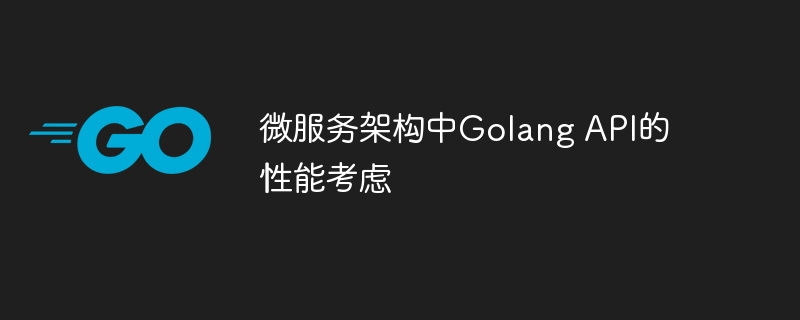Maison >développement back-end >Golang >Considérations sur les performances de l'API Golang dans l'architecture de microservices
Considérations sur les performances de l'API Golang dans l'architecture de microservices
- WBOYWBOYWBOYWBOYWBOYWBOYWBOYWBOYWBOYWBOYWBOYWBOYWBoriginal
- 2024-05-07 18:36:011280parcourir
Afin d'optimiser les performances de l'API Go, il est recommandé de : 1. Utiliser un mécanisme de mise en cache de fichiers statiques ; 2. Utiliser un mécanisme de traçage distribué pour suivre le processus de traitement des requêtes afin de découvrir et de résoudre les goulots d'étranglement des performances. Ces technologies peuvent réduire efficacement la latence et améliorer le débit, améliorant ainsi les performances globales et la stabilité de l'architecture des microservices.

Optimisation des performances de l'API Go dans l'architecture de microservices
Introduction
Dans l'architecture de microservices, les performances sont cruciales. Cet article se concentrera sur la façon d'optimiser les performances des API Go grâce à diverses techniques pour réduire la latence et augmenter le débit.
Exemple de code
Mise en cache statique de fichiers
// ./handlers/cache.go
package handlers
import (
"net/http"
"time"
"github.com/go-cache/go-cache"
)
// Cache is an in-memory cache.
var Cache = cache.New(5*time.Minute, 10*time.Minute)
// CacheRequestHandler is a middleware that caches HTTP responses.
func CacheRequestHandler(next http.Handler) http.Handler {
return http.HandlerFunc(func(w http.ResponseWriter, r *http.Request) {
// Check if the response is already cached.
if cachedResponse, found := Cache.Get(r.URL.Path); found {
// If found, serve the cached response.
w.Write(cachedResponse.([]byte))
return
}
// If not found, call the next handler.
next.ServeHTTP(w, r)
// Cache the response for future requests.
Cache.Set(r.URL.Path, w, cache.DefaultExpiration)
})
}// ./main.go
package main
import (
"fmt"
"net/http"
"github.com/gorilla/mux"
"./handlers"
)
func main() {
r := mux.NewRouter()
// Add middleware to cache static file responses.
r.Use(handlers.CacheRequestHandler)
}Traçage distribué
// ./handlers/trace.go
package handlers
import (
"context"
"fmt"
"net/http"
"github.com/opentracing/opentracing-go"
"github.com/opentracing/opentracing-go/ext"
)
func TracesHandler(w http.ResponseWriter, r *http.Request) {
// Create a new span for this request.
span, ctx := opentracing.StartSpanFromContext(r.Context(), "traces")
// Add some tags to the span.
ext.HTTPMethod.Set(span, r.Method)
ext.HTTPUrl.Set(span, r.RequestURI)
// Simulate work being done.
fmt.Fprintln(w, "Hello, traces!")
// Finish the span.
span.Finish()
}// ./main.go
package main
import (
"fmt"
"net/http"
"github.com/gorilla/mux"
"github.com/opentracing/opentracing-go"
"github.com/uber/jaeger-client-go"
"github.com/uber/jaeger-client-go/config"
)
func main() {
// Configure and initialize Jaeger tracer.
cfg := &config.Configuration{
ServiceName: "go-api",
}
tracer, closer, err := cfg.NewTracer()
if err != nil {
panic(err)
}
defer closer.Close()
opentracing.SetGlobalTracer(tracer)
r := mux.NewRouter()
// Add route that uses tracing.
r.HandleFunc("/traces", handlers.TracesHandler)
}Conclusion
En mettant en œuvre ces techniques d'optimisation des performances, les API Go peuvent fonctionner efficacement dans une architecture de microservices, augmentant ainsi la satisfaction des utilisateurs et le système global. performance.
Ce qui précède est le contenu détaillé de. pour plus d'informations, suivez d'autres articles connexes sur le site Web de PHP en chinois!

